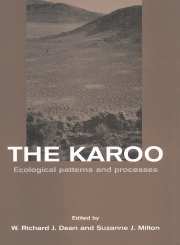Book contents
- Frontmatter
- Contents
- List of contributors
- Foreword
- Preface
- Acknowledgements
- Part one Biogeographic patterns and the driving variables
- 1 The climate of the karoo – a functional approach
- 2 Soils of the arid south-western zone of Africa
- 3 Palaeoenvironments
- 4 Plant biogeography, endemism and diversity
- 5 Biogeography, endemism and diversity of animals in the karoo
- Part two Form and function
- Part three Dynamics
- Part four Human impacts
- Part five Comparisons
- References
- Index
4 - Plant biogeography, endemism and diversity
Published online by Cambridge University Press: 23 December 2009
- Frontmatter
- Contents
- List of contributors
- Foreword
- Preface
- Acknowledgements
- Part one Biogeographic patterns and the driving variables
- 1 The climate of the karoo – a functional approach
- 2 Soils of the arid south-western zone of Africa
- 3 Palaeoenvironments
- 4 Plant biogeography, endemism and diversity
- 5 Biogeography, endemism and diversity of animals in the karoo
- Part two Form and function
- Part three Dynamics
- Part four Human impacts
- Part five Comparisons
- References
- Index
Summary
Introduction
The extraordinary plant diversity and floristic peculiarity of southern Africa's arid lands are often overshadowed by the better studied and more widely publicized Cape Floristic Region. While Cape fynbos has its analogue in the Kwongan of Mediterranean south-western Australia (Cowling et al., 1996), the flora of southern Africa's winterrainfall karoo, with its vast number of succulent species, is in a league of its own. A major objective of this chapter is to describe this diversity and seek explanations for its origins. We do this by analysing patterns and correlates of restricted range size (or endemism), and patterns and determinants of diversity at different spatial scales.
This chapter also provides the phytogeographical context for many of the other chapters in this book. We skim through this section, reluctant to become embroiled in the typological controversies that have characterized karoo phytogeography. Readers are referred to Werger (1978a, 1978b) and Jrgens (1991) for details.
Finally, we wish to clarify the use of some terms in this chapter. First, we use the term ‘Karoo–Namib Region’ to describe, in a phytogeographical context, the semi-arid shrubland and desert areas of southern Africa (Werger, 1978a). Although Jürgens (1991) provides justification for dividing this region into two phytochoria of equal rank, we retain the term as a matter of convenience. Second, our species counts always refer to vascular plants only. Third, we use the terms ‘species’ instead of the more long-winded ‘species and infraspecific taxa’. Fourth, as a result of ongoing taxonomic debate, we have (reluctantly) included the Mesembryanthemaceae, southern Africa's most speciose and interesting arid-land taxon, in the Aizoaceae (Bittrich and Hartmann, 1988; Hartmann, 1991).
Information
- Type
- Chapter
- Information
- The KarooEcological Patterns and Processes, pp. 42 - 56Publisher: Cambridge University PressPrint publication year: 1999
Accessibility standard: Unknown
- 29
- Cited by
